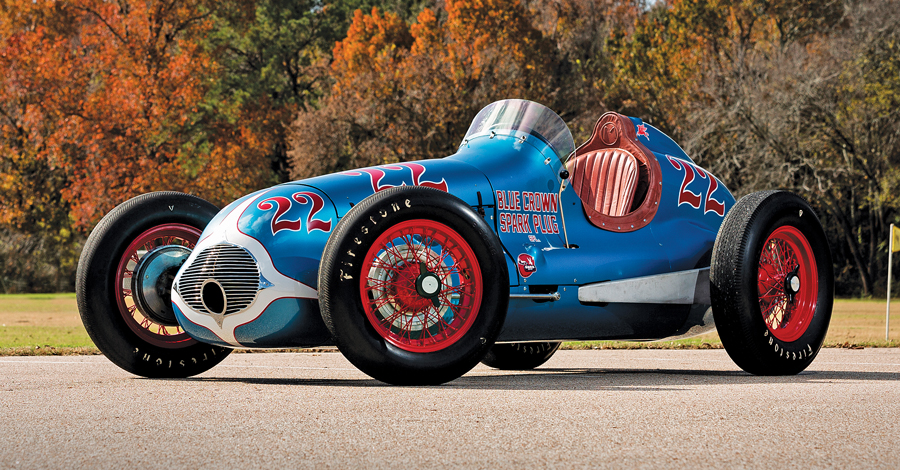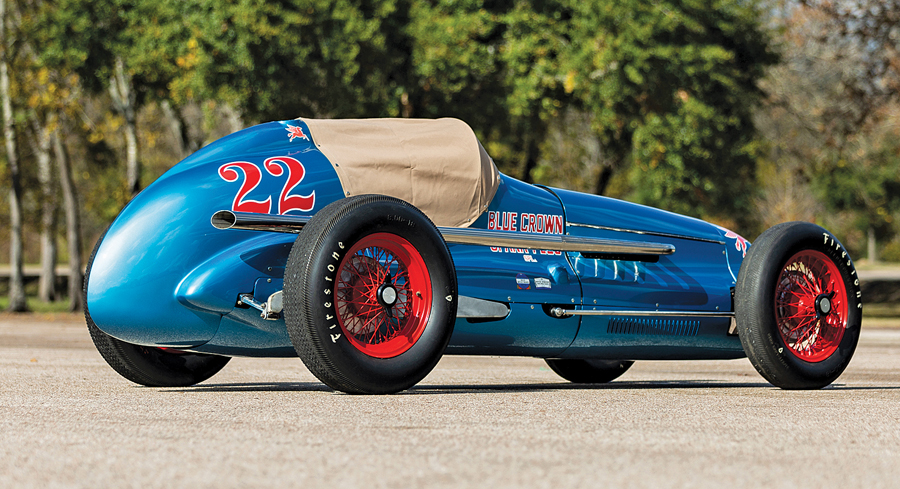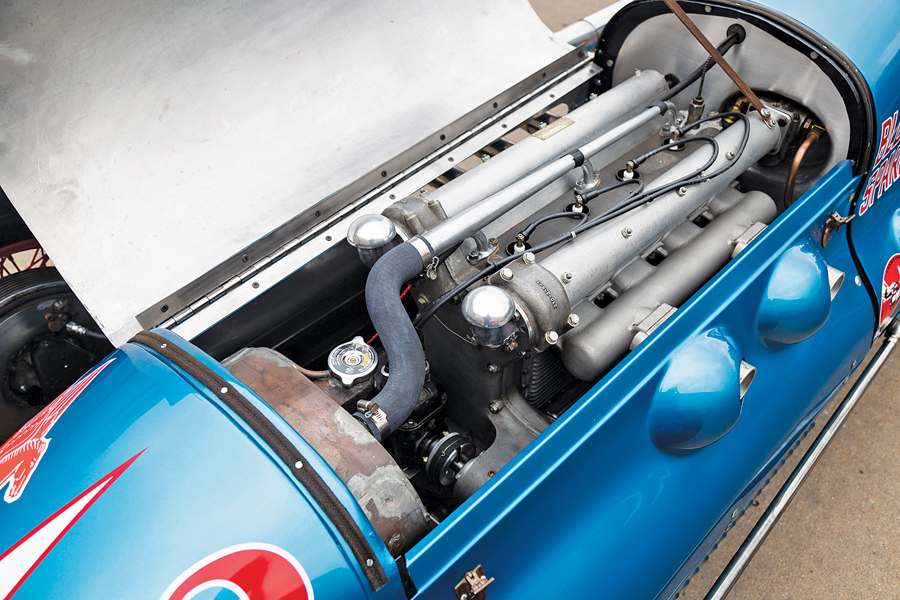SCM Analysis
Detailing
| Vehicle: | 1948 Lesovsky-Offenhauser Indianapolis “Blue Crown Special” |
| Years Produced: | 1948 |
| Number Produced: | One |
| Original List Price: | N/A |
| SCM Valuation: | $201,600 (this car) |
| Engine Number Location: | Tag on right cam cover |
| Club Info: | Historic Champ/Indy Car Association |
| Website: | http://www.champindycar.com |
| Alternatives: | 1960 Ken-Paul Offy, 1951 Offenhauser Blue Crown Special, 1952 Kurtis Kraft 400/Bowes Seal Fast Special or any other 1946–60 Indianapolis racer |
| Investment Grade: | A |
This car, Lot 171, sold for $201,600, including buyer’s commission, at RM Sotheby’s Arizona Auction on January 19, 2019.
There are as many reasons to buy an old racing car as there are cars and buyers, but they generally fall into one of a few basic categories.
In no particular order I refer to these categories as:
1) Weapons-grade racers.
2) Significant and collectible racers that can be — and need to be — driven.
3) Important collection pieces that may occasionally get used at the track or on tours.
4) Furniture. At the risk of irritating some readers, I suggest that our subject car is in this category and needs to be understood in that light.
Before dropping into that discussion, let’s take a brief tour of the Indianapolis racers from the 1930s through the early 1960s.
Indy car history
Beginning with the Great Depression during the 1930s, Indy tried moving away from the sleek, tiny Miller missiles of the late 1920s toward something more affordable. The rules specified two seats with a required rider, and production engines and chassis were encouraged over pure racing ones.
Economic recovery brought a return to purpose-built, single-seat racers. Starting in 1937, Indianapolis adopted the international Grand Prix rules (3-liter supercharged, 4.5-liter normally aspirated) and got the 500 added to the international championship calendar. Their thought was to establish the 500 as a truly international race, but the 4,200 miles from Indy to Paris in the days before air freight made European participation sparse.
What did happen is that American dirt-track racers quickly adapted to run the 2.5-mile paved oval, evolving over the years to optimize for the Indianapolis track (though most of them also continued to run dirt tracks as well). These are the second category, often described as “upright” racers, and they include our subject car. The engine of choice was the 272-ci (4.5-liter) Offenhauser 4. It sat in front and drove a minimal transmission to a live rear axle, with the driver sitting on top of the driveline, his feet straddling the transmission. This arrangement made for relatively tall, narrow cars with high centers of gravity, but it was state of the art at the time.
In 1952, Frank Kurtis came up with the idea of offsetting the engine to the left and having the driver sit beside the driveline instead of on top of it.
This had multiple advantages in that it moved the static weight to the inside, so that it was more even on the tires under cornering load (left turns only, of course) and got the driver’s weight much lower in the chassis.
The new wide, low look reminded people of the California hot rod “roadsters,” so that name stuck. “Indy Roadsters” dominated racing into the late 1950s. This is the third category. The power remained the venerable Offenhauser, now labeled a Meyer-Drake but essentially unchanged.
In 1958, designers started laying the engine on its side in the chassis, further lowering the car’s center of gravity to improve handling. These cars are called the “Laydown Roadsters” and held sway until the mid-engine revolution arrived from Europe and made everything before them obsolete.
Hot, noisy and scary
These Indy cars are all bespoke racers that are strictly limited to track use. They all use pretty much the same engine, and none of them are particularly easy or fun to drive.
They are hot, noisy, dirty, uncomfortable and very scary for anyone not already accustomed to the risk and vulnerability inherent in driving them fast. The very brave heroes who raced these cars really were that — accidents were common and drivers seldom walked away unscathed.
The 1948 “Blue Crown Special”
Our subject car was originally built in 1948 for Lou Moore, a driver and team owner sponsored by the Blue Crown spark-plug company.
Moore and his various “Blue Crown Specials” were very successful in the early post-war years, winning the Indy 500 five times. This car was unusual in that it was built as a short-wheelbase approach and was thus visually smaller than most of its competitors.
It was known at the time as the “Baby Blue Crown.”
The short wheelbase is more appropriate to dirt-track racing, so I suspect that running at Indy was not its original purpose, although it spent plenty of time there. It is certainly a pretty thing. Resplendent in blue and red, it is an archetype of what the upright racers should look like.
What to do?
Let’s get back to the question of why someone would want to buy this car, which in turn, gets us to issues of value.
This car makes no sense as a weapons-grade racer. Using carburetors rather than Hilborn injection makes things easier, but any Offenhauser is brutal to use — plus there is no provision for an on-board starter.
To run the car at all requires a crew, there are only a few vintage oval events in any given year, and running it on a road track would be challenging at best.
If you want to race, there are better options.
Really cool furniture
Assigning the car very much historic significance, which is a prerequisite to attaining serious collector value, is a difficult proposition. Yeah, the car ran the 500 quite a few times — and even placed 3rd once. However, nobody alive remembers any of the drivers.
With no heroic drives or thrilling victories to recommend it, the car’s glory is limited to nostalgia and its Blue Crown livery — and that’s mostly an appearance thing.
It might seem insulting at first blush, but there is really nothing wrong with thinking of a car as furniture, and this car is a perfect example.
Imagine, if you will, the perfect man cave filled with mid-century automobilia. Maybe there is a late pre-war Ford convertible and a post-war woodie wagon, some ’50s hot rods, a Vincent or BSA motorcycle or two, and you are almost there.
The scene needs a centerpiece, and here is where our Blue Crown Special (along with maybe an Indy Roadster or two) make everything just perfect.
I don’t know who bought this car or why, but I will almost guarantee that something close to what I have just described is where it ended up.
Two-hundred grand is not an unreasonable investment in a delightful blue centerpiece. ♦
(Introductory description courtesy of RM Sotheby’s.)



